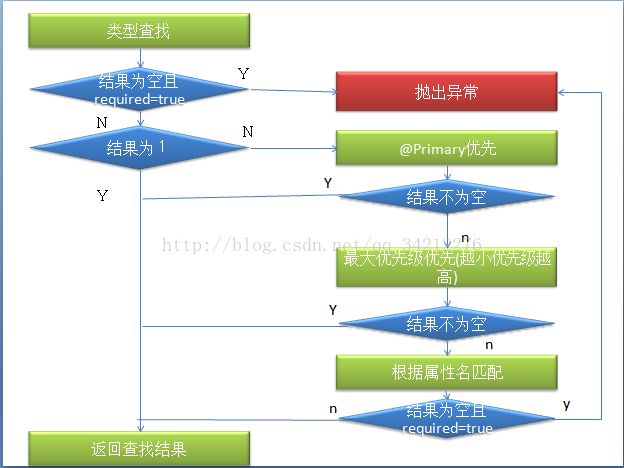Spring IOC三种注解注入Inject、Resource、AutoWired区别与IOC注入过程
1、
@AutoWired是Spring自带的方式
@Resource是JSR-250标准,JDK6以上自带,Spring版本要求2.5以上
@Inject是JSR-303标准,Spring版本3以上。需要导入外部依赖。
2、
@AutoWired可以用在构造器、方法、属性、参数、注解上面.
@Resource可以用在方法、属性、类上。
@Inject可以用在方法、属性、构造器上。
ps:当用在属性上面注入时,无须为该属性添加setter方法。
3、
@AutoWired注入可以根据名字/类型,可以设置required属性为false指定找不到相应bean时不抛异常
@Resource注入与@AutoWired一致。但可以指定name属性来指定beanName,但如果name对应的bean不存在,则会抛出异常,且没有required属性
@Inject与@AutoWired一致,区别在于@Inject没有required属性
4、
@Inject:通过AutowiredAnnotationBeanPostProcessor类实现依赖注入
@Autowired:通过AutowireAnnotationBeanPostProcessor类实现依赖注入
@Resource:通过CommonAnnotationBeanPostProcessor类实现依赖注入。
5、Spring的IOC注入过程
在Spring所管理的类里面,在要注入的对象属性或者setter方法加上上面三个任意一个注解或者在xml文件中配置
上述步骤可以分解为以下几个步骤,如图所示:
每次调用getBean时并不总是会调用doCreateBean方法,如果要获取的对象是singleton的,会先从工厂里面获取,否则会走这个流程。但无论是singleton还是prototype还是scope为其他类型,都会走一遍这个流程。
具体来看populateBean()方法:
protected void populateBean(String beanName, RootBeanDefinition mbd, BeanWrapper bw) {
PropertyValues pvs = mbd.getPropertyValues(); //当前bean要注入的属性
if (bw == null) {
if (!pvs.isEmpty()) { //要注入的属性不为空,但beanWrapper为空 抛出异常
throw new BeanCreationException(
mbd.getResourceDescription(), beanName, "Cannot apply property values to null instance");
}
else {
return;
}
}
boolean continueWithPropertyPopulation = true;
//这儿处理注解配置,使用不同的注解注入的类会有所不同
if (!mbd.isSynthetic() && hasInstantiationAwareBeanPostProcessors()) {
for (BeanPostProcessor bp : getBeanPostProcessors()) {
if (bp instanceof InstantiationAwareBeanPostProcessor) {
InstantiationAwareBeanPostProcessor ibp = (InstantiationAwareBeanPostProcessor) bp;
if (!ibp.postProcessAfterInstantiation(bw.getWrappedInstance(), beanName)) {
continueWithPropertyPopulation = false;break;
}
}
}
}
if (!continueWithPropertyPopulation) { //是否需要注入属性,不需要则bean构造已完成
return;
}
//处理注入类型,byName还是byType, 注解的注入不会进入这儿,配置文件不指定autowire或者指定为default也不会进入这儿
//这儿并没有完成IOC,只是根据名字或者类型找到对应bean
if (mbd.getResolvedAutowireMode() == RootBeanDefinition.AUTOWIRE_BY_NAME ||
mbd.getResolvedAutowireMode() == RootBeanDefinition.AUTOWIRE_BY_TYPE) {
MutablePropertyValues newPvs = new MutablePropertyValues(pvs);
if (mbd.getResolvedAutowireMode() == RootBeanDefinition.AUTOWIRE_BY_NAME) {
autowireByName(beanName, mbd, bw, newPvs);
}
if (mbd.getResolvedAutowireMode() == RootBeanDefinition.AUTOWIRE_BY_TYPE) {
autowireByType(beanName, mbd, bw, newPvs);
}
pvs = newPvs;
}
boolean hasInstAwareBpps = hasInstantiationAwareBeanPostProcessors();
boolean needsDepCheck = (mbd.getDependencyCheck() != RootBeanDefinition.DEPENDENCY_CHECK_NONE);
//注解注入,xml的配置不会走这儿
if (hasInstAwareBpps || needsDepCheck) {
PropertyDescriptor[] filteredPds = filterPropertyDescriptorsForDependencyCheck(bw, mbd.allowCaching);
if (hasInstAwareBpps) {
for (BeanPostProcessor bp : getBeanPostProcessors()) {
if (bp instanceof InstantiationAwareBeanPostProcessor) {
InstantiationAwareBeanPostProcessor ibp = (InstantiationAwareBeanPostProcessor) bp;
pvs = ibp.postProcessPropertyValues(pvs, filteredPds, bw.getWrappedInstance(), beanName);
if (pvs == null) {
return;
}
}
}
}
if (needsDepCheck) {
checkDependencies(beanName, mbd, filteredPds, pvs);
}
}
//其他注入,如List Map等,xml配置的注入也是在这个方法完成的
applyPropertyValues(beanName, mbd, bw, pvs);
}
下面是该方法的部分源代码:
public Object doResolveDependency(DependencyDescriptor descriptor, String beanName,
Set autowiredBeanNames, TypeConverter typeConverter) throws BeansException {
//如果要注入的List、Map类型
Object multipleBeans = resolveMultipleBeans(descriptor, beanName, autowiredBeanNames, typeConverter);
if (multipleBeans != null) {
return multipleBeans;
}
//如果要注入的是单个对象,不是集合类型
//根据类型来查找匹配的bean
Map matchingBeans = findAutowireCandidates(beanName, type, descriptor);
if (matchingBeans.isEmpty()) {
if (isRequired(descriptor)) { //没找到匹配的bean,会根据是否设置了required=true来抛出异常
raiseNoMatchingBeanFound(type, descriptor.getResolvableType(), descriptor);
}
return null;
}
String autowiredBeanName;
Object instanceCandidate;
//找到的bean的个数大于1
if (matchingBeans.size() > 1) {
//通过名字来匹配
autowiredBeanName = determineAutowireCandidate(matchingBeans, descriptor);
if (autowiredBeanName == null) { //没找到名字匹配的bean,根据是否设置了required抛出异常
if (isRequired(descriptor) || !indicatesMultipleBeans(type)) {
return descriptor.resolveNotUnique(type, matchingBeans);
}
else {
// In case of an optional Collection/Map, silently ignore a non-unique case:
// possibly it was meant to be an empty collection of multiple regular beans
// (before 4.3 in particular when we didn't even look for collection beans).
return null;
}
}
instanceCandidate = matchingBeans.get(autowiredBeanName);
}
else {
//这种情况下根据类型找到了唯一的bean
// We have exactly one match.
Map.Entry entry = matchingBeans.entrySet().iterator().next();
autowiredBeanName = entry.getKey();
instanceCandidate = entry.getValue();
}
if (autowiredBeanNames != null) {
autowiredBeanNames.add(autowiredBeanName);
}
return (instanceCandidate instanceof Class ?
descriptor.resolveCandidate(autowiredBeanName, type, this) : instanceCandidate);
}

然后在各自的inject方法中调用resolveDependency方法。最后根据java reflect反射设置进去,这也是为什么在private属性上加上注解依旧能注入进去的原因。
而xml最终是使用下面的图上的类来完成注入的:
注入完成后代表构造bean的过程结束,最终会将构造完成的bean返回给调用者。
整个过程如图:
需要注意的是:
1、注解注入比xml配置注入先发生。
2、找寻bean的过程,根据类型匹配到的bean的个数如果大于1,并不是马上根据name匹配,而是先寻找有@Primary注解的bean,如果没有则寻找@Order注解的bean并且@Order的value属性最小的bean,如果@Primary和@Order都没找到,则会根据field的name匹配。ps:好像@Order配置bean不起作用
3、如果使用@Autowired注入并且使用@Qualifier指定name,则查找时会根据类型与名字查找,如果查找结果为空,则会抛出异常。
4、如果使用@Resource指定name属性与第三点一致。
所以当不指定bean的name属性时:
当指定name时:
最后注入时注解最好加在setter方法上面,因为field属性一般都是声明为private,通过反射不能直接访问,会调用setAccessible(true),但这个方法可能会因为权限不足而抛出异常。
以上就是个人理解的Spring IOC注入过程。但因个人水平原因,可能不全面或者有不对的地方,欢迎评论留言。




